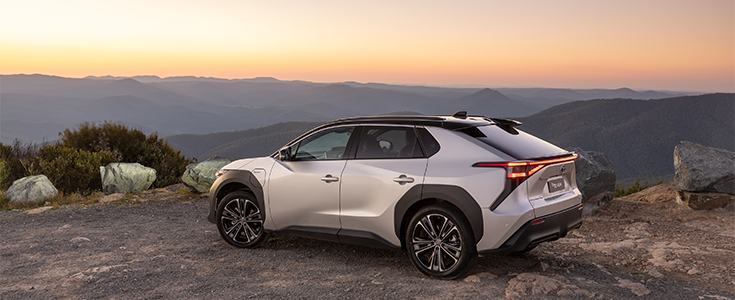





Built on the new e-TNGA dedicated EV platform, the bZ4X has a similar footprint as the 300 Series LandCruiser, despite its external dimensions being much closer to the smaller RAV4.
The result is an abundance of rear leg room (with tiltable rear seats further improving rear passenger comfort), but this area has clearly taken precedence over boot space, of which the bZ4X falls nearly 100 litres short on the RAV4 (452 versus 542 litres) and trails other EV SUV competition.
Styling inside and out is standard Toyota, causing neither excitement nor concern. Excessive use of piano black on interior pieces can lead to glare at certain times of day, but driving ergonomics are logical.
A sleek body shape contributes to a very low drag coefficient of 0.218 – just undercutting the revised Tesla Model 3’s 0.219. However, despite the bZ4X’s slickness, driving range is underwhelming, with Toyota claiming 436km for the FWD and 411km for the AWD on the WLTP cycle. These fall short of the Tesla Model Y, Polestar 2 and Hyundai Kona.
Australian-delivered variants do receive updated battery management tech to aid in charge times and energy use, but the bZ4X still only sees a maximum charging rate of 150kW DC and 11kW AC. It also misses out on vehicle-to-load and vehicle-to-grid functionality seen in some of its competitors.
The warranty period for the bZ4X (including its high-voltage battery) is five years/unlimited-kilometre. With annual inspections by Toyota, this can be increased to seven years for its electric motor(s) and drivetrain, and 10 years for the battery. These may not be deal-breakers today, but with the bZ4X a new release and unlikely to see updates for a while, they may become larger shortcomings over time.
The bZ4X may appear lacking on its spec sheet, but it’s a solid performer on the road (and sometimes off it).
In both trims steering feel and ride quality are excellent, however stability belongs to the AWD, with the FWD sometimes a little clumsy on twisty roads.
Torque from a standstill is limited – something that makes sense as a traction-aid for FWD models but is unnecessary on the AWD model (and it robs the electric powertrain of its urgency). The torque difference between the two variants also doesn’t feel as pronounced as the figures suggest, with the 10kW power differential more noticeable in real-world scenarios than the 71Nm of torque.
Our test loop included a section of unsealed road with some moderately challenging rocky sections. The AWD bZ4X (and its 212mm ground clearance) took the challenge with ease and, while it might not be climbing any mountains, buyers should feel comfortable knowing it’s not out of its element off-road.
The bZ4X is a strange entry from Toyota, presenting more as a reaction to calls for one of the world’s largest automotive brands to offer an electric option than an attempt to innovate. The brand seems to have taken the ‘electric car’ brief literally – the bZ4X feels like any other Toyota passenger car, only driven by electric motors.

That said, Toyota sells segment-toppers across the Australian market, and its knowledge of how to build cars and what consumers want seems beyond question. While the bZ4X doesn’t really pioneer in any way, there isn’t anything it really gets wrong, either.
A solid but unremarkable electric car wearing a badge many have come to associate with safe and reliable motoring could be just what Australians are after.
Pros: Solid performance on- and off-road; refined ride quality; build quality
Cons: Driving range; tech suite compared to rivals; boot space